The Latest from TechCrunch |  |
| Study: One in Five U.S. Homes Are Cellphone Only Posted: 11 May 2009 07:54 AM PDT  The CDC's report on wireless substitution - aka canceling your land line for a cellphone - is out and we discover that one in five U.S. households have cut the cable, an increase of 2.7 percent over six months ago. Another tidbit: one in every seven American homes (14.5%) took all their calls on cellphones despite having a landline. The report polled 12,597 families for 23,726 adults total - there were 8,635 kids under the age of 18 - which makes it a fairly strong sample size. A few other tidbits: The CDC's report on wireless substitution - aka canceling your land line for a cellphone - is out and we discover that one in five U.S. households have cut the cable, an increase of 2.7 percent over six months ago. Another tidbit: one in every seven American homes (14.5%) took all their calls on cellphones despite having a landline. The report polled 12,597 families for 23,726 adults total - there were 8,635 kids under the age of 18 - which makes it a fairly strong sample size. A few other tidbits: |
| Go Nordic With TechCrunch, May 27, Stockholm Posted: 11 May 2009 07:01 AM PDT
Crunch Network: CrunchBase the free database of technology companies, people, and investors |
| Get The Real-Time Twitter Scoop With Twitscoop Posted: 11 May 2009 07:00 AM PDT
Twitscoop, a real-time visualization tool that lets you see hot trends and buzz on Twitter, is getting a makeover and adding several useful features that may help you “mine the thought stream.” These features will officially roll out at 8 AM PST. Twitscoop’s algorithm identifies tags and keywords in the Twitter stream and then ranks them by how frequently they appear versus normal usage. Twitscoop detects growing trends in real-time, identifies breaking news and then monitors specific keywords along with graphs that display the activity for any given word on twitter. The results are also displayed in a “Tag Cloud,” where the hotter tags are presented in a bigger front. Besides showing the trending topics on Twitter, Twitscoop, which provides a service similar to Tweetag, Tweetmeme, and Twitturly, also lets you search Twitter messages for trending topics. Twitscoop is becoming a full-fledged Twitter service, adding oAuth to let you sign in with your Twitter account and tweet from the site without leaving the page. Additionally, you will be able shorten urls and tweet searches from the site. The new additions to Twitscoop’s roster of features include a new and improved real-time tracking code and a redesign of the user interface. The right side of Twitscoop’s homepage displays in real-time the words which are “buzzing” right now on Twitter. This tag cloud is updated automatically, with tags continuously appearing, growing, shrinking and finally vanishing. When you hover over a tag, a popup window will appear, displaying the latest related tweets about the tag. If you click on the tag, you open up a search tab within the site which will display all the related tweets along with a custom graph showing the tags’ activity over the past few hours or days. The graph is an interesting feature that isn’t available on most of Twitscoop’s competitors and helps you understand the timeline of a trending topic. On the left side of the homepage, Twitscoop shows general “trends” detected on Twitter. Clicking on any hot trend will open a tab with a snapshot of the corresponding search results by time frame, from 6 hours to 1 day to 3 days. I’m a fan of the way Twitscoop saves multiple searches in different tabs within the site. It makes it very easy to jump from one search to another without having to conduct the search over again. 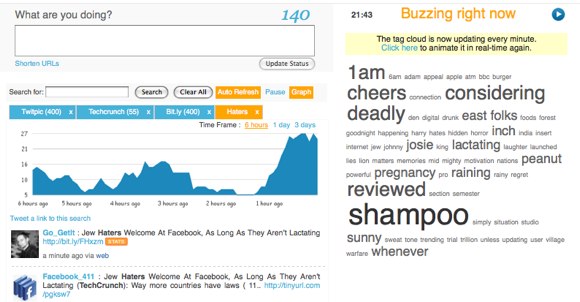 Unlike competitor Tweetmeme, which measures trends and hot topics by links and is also adding innovative features, Twitscoop measure trends by keyword. Tweetag, another tag-based search engine for Twitter that also uses a tag cloud to show results, is also useful but doesn’t include the interactive graphs and in-depth features of Twitscoop. Twitter, which acquired Summize, whose technology currently powers Twitter Search, also features trending topics but doesn’t go into the same depth as Twitscoop either. Twitscoop has lofty ambitions—the site hopes to not only be a go-to application to measure trends and buzz on Twitter, but also wants to be a major Twitter client, albeit a Web-based one. This field is packed with many worthy competitors including Seesmic Desktop, Tweetie, Tweetdeck, Twitterific, and Nambu. Although it’s doubtful that Twitscoop will be able to take a large piece of the Twitter client pie, the site provides a useful way to find out what’s happening on Twitter that’s buzzworthy in real-time.  Crunch Network: CrunchGear drool over the sexiest new gadgets and hardware. |
| Microsoft Surface SP1 Adds New Features, Better Support Posted: 11 May 2009 06:59 AM PDT  This last Friday, a few of the developers behind Microsoft Surface took some time out of their schedules to meet with us and talk about what's coming in their Surface Service Pack 1, due to be rolled out today. Now, it's called a service pack for a reason — as opposed to a fun pack — this update is a response to the requests and concerns of the community using and developing for the Surface, so it's not about flashy new gizmos and eye candy, but usability. There are still a few new visible features, and it's always fun to play with a Surface, so there's a nice video for you to watch if you're interested in how the Surface is changing and how Microsoft is responding to developer feedback. It's easier to show them than explain them at length, so check them out in the exclusive video inside. This last Friday, a few of the developers behind Microsoft Surface took some time out of their schedules to meet with us and talk about what's coming in their Surface Service Pack 1, due to be rolled out today. Now, it's called a service pack for a reason — as opposed to a fun pack — this update is a response to the requests and concerns of the community using and developing for the Surface, so it's not about flashy new gizmos and eye candy, but usability. There are still a few new visible features, and it's always fun to play with a Surface, so there's a nice video for you to watch if you're interested in how the Surface is changing and how Microsoft is responding to developer feedback. It's easier to show them than explain them at length, so check them out in the exclusive video inside. |
| Fotomoto Lets Photographers Sell Photos On-Site Without The Hassle Posted: 11 May 2009 06:02 AM PDT
Fotomoto does things differently: photographers only need to insert a few lines of codes in their website, after which the images on his or her website will automatically be indexed and automatically provided with a ‘purchase photo’ link. Sellers can tweak the settings so the ‘buy’ links appear completely integrated and branded to match their sites’ look and feel, and the back-end of the tool enables them to set the availability next to the sizes and pricing of the photos. When visitors click the link to buy photos, a Fotomoto widget pops up and enables them to instantly purchase images through PayPal (with the ability to pay by credit card coming later this month). There’s also a sharing link, which lets people send the picture to others as an e-card, with the ability to push to social networking and bookmarking services coming in a couple of weeks. You can see the integrated code in action on photo websites daily dose of imagery and Chromasia (under the photos). Photographers and publishers pay a commission when an actual sale takes place, so no paid monthly subscription or anything like that is required for them to start offering this service to their fans. The fee that they pay Fotomoto depends on the printing cost and the price the photo was set to in the first place - the startup asks for a 15% commission fee to cover cost and payment processing fees. Soon, Fotomoto will start offering a number of extra printing services, like postcards, t-shirts, merchandise and the likes which it hopes will drive more sales (and revenue for both them and photographers). It’s also slowly going to make its main site a place where you can discover photos from various photographers and instantly buy them from an iStockphoto-type directory.
What I dig about the service is that Fotomoto clients get to dispose over detailed statistics on which photos perform well in terms of view count, orders, etc. which helps them evaluate which direction best to take for commercial success. That’s a really good selling point for starting and established photographers alike, but also for publishers (media groups etc.) who would like to cash in on that part of their content offering that rarely gets brought up in online media monetization discussions. Fotomoto launched about 3 weeks ago and currently has close to 27,000 photos in its database from about 125 photographers, with over 100 orders completed successfully so far. The company was started in October 2008 and raised seed funding to the tune of $300,000 from early-stage financing firm Amidzad Partners and DFJ soon after. It’s currently looking for an additional round of funding together with one of its notable board members, And Wood, former CEO of ShutterFly and also former CEO of PhotoWorks. Crunch Network: MobileCrunch Mobile Gadgets and Applications, Delivered Daily. |
| Kyte Streams 50 Million Videos A Month. Rolls Out iPhone Apps For MTV, NBA, And Others. Posted: 11 May 2009 04:43 AM PDT
In an age when anyone with a video-capable cell phone can have their own TV channel on the Web, it is still the celebrities and rock stars who are getting all the views (just as on Twitter they get the most followers). Kyte CEO Daniel Graf knows this fact all too well. Of the 215,000 video channels on Kyte, nearly all are created by consumers, but only about 1,000 account for more than 90 percent of the mobile videos streamed via the service. And those 1,000 channels are invariably the work of professionals or the cell-phone videos of famous people such as musicians Lady Gaga (iTunes link) and Soulja Boy (iTunes link) In April, Kyte streamed 50 million videos across the Web, mobile devices, and social networks. Just to put those 50 million video streams into perspective, that is half the number of videos streamed in March, 2009 by AOL, the tenth ranked video site in the U.S. (Hulu, which is No, 3, streamed 380 million videos). Today, Kyte is launching iPhone apps for partners including MTV, the NBA, Spin Magazine, the rock band No Doubt, and the Los Angeles radio station KCRW, which is using the app to highlight videos of bands playing live in its studios. Some of these apps are tailored to specific events such as the MTV Movie Awards and the NBA Playoffs (iTunes link). Kyte creates iPhone apps as a turnkey service, with the ability to add different modular features to each app. These features include video shows based on mobile Kyte uploads; blog, news, and Twitter feeds; live chat; a presence indicator showing how many other people are currently in the app; music or video downloads via the iTunes store; location-aware event listings for tour dates and other listings, mobile Web access, and custom modules such as basketball scores Kyte is taking off, but not because of user-generated videos. Rather it is trying to cash in on the premium slice of video content out there, much like Hulu is for Web video. The difference is that Kyte creates consistent branded video experiences across Websites, social networks, and mobile devices. Graf doesn’t see Kyte competing so much against Qik and UStream on the mobile live streaming video front as it does against Brightcove in the enterprise video publishing. Pitches Graf: “We are cheaper than Brightcove and you get mobile as well and Twitter and Facebook.” Kyte wants to become the one-stop shop for major talent and media brands, wrapping their Websites and iPhone apps around mobile video. My problem with the apps is that they are only as good as the content they showcase. The iPhone apps are very consumption-oriented. For instance, Twitter is treated as nothing more than a straight, one-way feed instead of turning letting fans Tweet back from within the app. In the video below, which I took last week when Graf visited my office, he talks about the new iPhone apps, how the Kyte platform ties together mobile, Web, social Networks, and Twitter, and how he sees Brightcove as his biggest competition: Crunch Network: MobileCrunch Mobile Gadgets and Applications, Delivered Daily. |
| NBC Invests In Video Search Startup EveryZing And Signs Up As Its Biggest Customer Posted: 11 May 2009 03:00 AM PDT
Video search startup EveryZing just landed its biggest fish yet: NBC Universal. Boston-based EveryZing signed a master service agreement with NBC to provide video search and search-optimization technologies across all of its online properties, which include NBC.com, iVillage, CNBC.com, and the websites for Bravo, Sci-Fi, and Telemundo. (The deal does not cover Hulu, which is a joint venture between NBC and Fox). NBC is also investing in the company, leading its latest $8.25 million C round, through its venture capital arm, the Peacock Equity Fund. Peacock Equity put in $3 million of the total, with existing investors Fairhaven Capital, General Catalyst Partners, Accel Partners and BBN Technologies putting up the rest. The valuation was flat with the last $10 million round the company raised in 2007. With the partnership, EveryZing will start powering search across NBC’s sites, starting with CNBC.com in a few weeks. As an enterprise search company, EveryZing offers a universal search box for finding not just video, audio, but also text results within a site or network of sites. After ingesting all of the video and audio content, it uses natural language processing and speech-to-text technologies to create a searchable transcript. As NBC digitizes its vast archive of TV shows, many of which are stored on old videotapes that are beginning to deteriorate, EveryZing can process the video to make it searchable. (The technology originated at BBN). It can also do directed indexing of YouTube videos by ingesting all the videos on certain channels, for instance. As EveryZing creates transcripts for searching purposes, they also become available for contextual ad targeting in and around the videos themselves. NBC.com alone has streamed more than one billion full episodes of TV shows over the past 18 months, it recently announced. EveryZing will also be making available a chromeless, re-skinnable video player that includes the text of all the spoken words in the video, as well as the ability to play both related YouTube and Brightcove videos inside the same player. Crunch Network: CrunchGear drool over the sexiest new gadgets and hardware. |
| CubeTree Launches As A Facebook + FriendFeed + Twitter For Enterprise Posted: 10 May 2009 10:28 PM PDT
CubeTree’s new enterprise collaboration suite, which is opening to the public tomorrow, has a familiar look: It looks like a cross between Facebook and FriendFeed (more-so before they were both recently redesigned). And that familiarity is part of the idea to getting this to work on the enterprise level. As with other social networks, there are two main components to CubeTree: The Feed and the Profile. But on CubeTree’s feed, instead of seeing updates from everyone in your social graph, you see updates from coworkers. And on your profile page, rather than highlighting pictures or videos of yourself, there is an emphasis on information and documents. CubeTree co-founders Carlin Wiegner (also CEO) and Ross Fubini (also CTO), both formerly with Symantec, recently gave me a walk-through of their product. It’s impressive both in look and feel and scope. They’ve done a great job taking the best parts of the social networks I’ve mentioned above, and putting them into CubeTree with more of a business spin. And I think a lot of businesses may be receptive to that because a lot of their employees have already been trained to use social networks of this ilk, something which Wiegner also pointed out. And in huge companies (the biggest one CubeTree is currently testing with has about 100,000 employees), a network like this can give an employee a face. As you can see in the screenshots, CubeTree places a large emphasis on the micro-updates, just like Twitter. The rationale behind this is that there are often things people maybe want others to know, but don’t want to send out an email to everyone in the company, as Fubini notes. With status updates, employees can give passive updates to coworkers which show up in their stream throughout the day. But that’s not all that goes into the feed, like FriendFeed (and now Facebook), CubeTree can import elements from other social services such as Google Reader shared items, TripIt trips, Salesforce data and others. And just like FriendFeed (and again, now Facebook), anyone can now comment on these items in the feed. But lest you think CubeTree is just a straight knock-off of Facebook/FriendFeed/Twitter for enterprise, there are also several other more unique things it offers. For example, users can upload and share documents, set up goals, set up trip information, create Wiki pages for the company and even create company quizes for others to take. The last one is not what it sounds like, it’s not meant to test others aptitude, but rather fun exercises to get to know your follow coworkers. For example, you may ask a question like “FILL IN THE BLANK loves their iPhone the most.” Other employees then fill in their answers. “People love playing this game,” Wiegner says, noting that it wasn’t originally intended to be used exactly like that. CubeTree also offers a powerful search option to look for things across the network — particularly handy for documents. And there is a “track” option, just like Twitter used to have to alert you when some key word is said. Almost everyone immediately tracks their names, Wiegner and Fubini joked. It’s important to note that social relationships within CubeTree are much like they are on Twitter. That is to say rather than having to friend someone and have them friend you back, you can simply follow anyone in the company you wish. That seems a bit odd since this is an internal company product, so it would seem reasonable that everyone should follow everyone else, but CubeTree wants to make sure users have options still within the company as to how they want to interact with the product. Seeing as CubeTree runs entirely in the cloud, security is an obvious concern, but Wiegner and Fubini, who again both came from Syamantec, placed an emphasis on security from day one and note that CubeTree has passed many leading security tests. That was apparently enough to get at least a few Fortune 500 companies to sign up to test the product out. Right now, the product is being tested with about 100 companies ranging in size from 20 people to 100,000, Wiegner says. There are quite a few competitors to various parts of CubeTree, but the company is convinced that it has the most comprehensive offering across the board. For example, Yammer does the micro messaging aspect for businesses, but doesn’t have all of the other social elements. Then there’s the enterprise wiki work that Socialtext leads the field in, but it too doesn’t have all the other elements. As for pricing, CubeTree has three tiers. The first is the free product which is called “Standard” and offers a company unlimited accounts that are limited to 10 megabytes of storage. The step up from that is “Group,” which for $3 per user per month offers 1 GB of storage and improved security. The third tier is “Enterprise,” which at $5 per user per month offers the best security, storage and management options. One nice thing about the bottom two tiers is that they’re compatible. So basically if you don’t want to buy all your employees the Group package, you can mix between Standard and Group. But if you want to upgrade to Enterprise, your whole network must be running it. There are bulk discounts though over 500 users. CubeTree was founded in 2008 with a seed round by Mitch Kapor and Trinity Ventures. It raised an undisclosed first round in April and will likely look for another round at the end of this year or beginning of next, according to Wiegner. Crunch Network: CrunchBase the free database of technology companies, people, and investors |
| Jew Haters Welcome At Facebook, As Long As They Aren’t Lactating Posted: 10 May 2009 08:52 PM PDT
Way more countries have laws against holocaust denial (11 or so) than breast feeding (0), but guess which one is banned on Facebook? That’s right. Pictures of breast feeding babies are indecent, so they’re a no go. But Holocaust denial is totally cool because it fosters open discussion. Facebook wants to “be a place where people can discuss all kinds of ideas, including controversial ones.” Even, apparently, the discussion of the idea that someone might be a “Nigger faggot, Jew nosed cunt.” That’s just one of many hateful messages I found written on a Holocaust denial site on Facebook. Brian Cuban is making the removal of these sites a personal mission. He’s arguing the law. He’s arguing terms of service. He’s arguing common sense and decency. These groups are clearly little more than excuses to spew hatred towards Jews, and Facebook is too timid to do anything about it. The first amendment doesn’t apply to private companies. So why is Facebook so willing to take a stand when it comes to hungry babies, but won’t do a damn thing when it comes to the Holocaust. Because they’re cowards. Here’s more open discussion of ideas on a Facebook Holocaust denial group:
Update: Up for debate is whether or not this image of Romanian children in Auschwitz, victims of medical experiments, is evidence of the Holocaust, which apparently may or may not have happened. But what isn’t debatable is whether or not this is pornography under Facebook’s TOS. It is. Yes, Facebook, this is the side of the line you’ve chosen to stand on.
Crunch Network: MobileCrunch Mobile Gadgets and Applications, Delivered Daily. |
| China: Where Patience Meets Speed Posted: 10 May 2009 07:35 PM PDT
But since it's early in the process, I'm still hitting many places for the first time, and it's a challenge. I’m continually throwing myself into a culture and trying to absorb as much as I can from being on the ground, meeting with hundreds of entrepreneurs, and trying to ferret out some TechCrunch-worthy and book-worthy stories. Two-to-three weeks can go past in the blink of an eye, and frequently I leave with more questions than answers. More maddening: That's usually a sign I've done my job. No place should be decipherable in two weeks. Especially not China. China has just exploded with entrepreneurship, funding and economic opportunity over the last five years or so, and unlike most of the world there doesn't seem to be a slow down yet. In 2002, U.S. investors pumped $437 million into China. By 2007 that had grown to $2.8 billion. And last year, it swelled again to $4.2 billion. All numbers courtesy of Dow Jones/VentureSource which should be releasing its first quarter China figures this week. Imagine Silicon Valley in 1999 times a huge sprawling country and population, and that's what I'm wading into for the next two weeks. On one hand, it's exhilarating. In the US, we've all heard so much about the amazing Chinese economic engine, looking on with a mix of terror, greed and awe. It's stunning actually to be on the ground here. But sifting through hundreds- even thousands- of Mandarin-speaking entrepreneurs is also a bit like trying to do an estate sale for Howard Hughes. There are priceless old films, keepsakes from starlets and antique aviator equipment, but also stacks of milk bottles, newspapers and nail clippings—where do you start? This mild panic I'm finding myself in has me thinking a great deal about two characteristics of China that people have been referencing in the last few weeks as I’ve been planning this trip and doing pre-interviews: Patience and speed. They're seemingly contradictory, and perhaps part of that is the collision of tradition and modernity in China right now. It's important to realize that patience isn't the same thing as being slow. It's a mindset thing, not a factor of how fast you are moving. The Chinese people have always known they'd be one of the world's major superpowers, known it with such conviction; they just had to let it unfold. And unfold it has. Even Internet entrepreneurs share this view, as Jack Ma of Alibaba said in this 2000 Forbes interview, “One must run as fast as a rabbit, but be as patient as a turtle.” Interestingly, Ma picks the good attributes of each animal: The speed of the rabbit but not the impatience and cockiness. And the patience of the tortoise but not the slow speed. (One could argue those are traits of large, fat and happy American multi-nationals that both Chinese and Silicon Valley startups seek to out-do.) Ma has also said that employees and customers come first, shareholders second. Why? They're incapable of holding a long term view and he refuses to run his business quarter-to-quarter. For Ma, ten years is a short time. For U.S. investors—even VCs—ten years is a long-term investment horizon. What many U.S. investors find baffling is how that patient mindset co-exists in a world that moves so quickly. Last night I had dinner with several ex-patriot entrepreneurs who said it'd be hard to leave Shanghai now because the speed with which the city runs has become addictive. Every few weeks there are new buildings. The restaurants open and close so quickly, one of the ex-pats says he calls a restaurant before he leaves the house, not to make reservations but to make sure its still there. Another laughed at the idea that he used to think Manhattan was fast-paced. He goes back to visit now, and it all seems the same. I'm not even 24-hours into my adventure in China, but I'm interested to learn more about how these two traits manifest themselves in the startup world here. Already, I'm hearing about a distaste for raising U.S. money because of an insistence on predictable and unnatural growth metrics. My guess is the successful investors will be the ones that yield to the Chinese way of thinking on this, not the reverse. Indeed, a short-term nature of investing is a big part of why our capital markets are broken, and over the last few decades as Wall Street funds and endowments have become the main backers of VCs, that short-term-thinking disease has spread into what used to be a risky but patient asset-class. Crunch Network: CrunchBase the free database of technology companies, people, and investors |
| Lois Whitman Now An Unwilling Case Study In How Not To Do PR Posted: 10 May 2009 05:33 PM PDT
Things quieted down when she issued an apology, saying “Official Apology to Rich Brome And All Offended Bloggers -Just posted this on Twitter. Received over 100 emails, most of them angry. They are right. I was wrong. Thank you for the support emails but this is the right thing to do. Amazed by the power of viral marketing and learned a lot. I should take the heat. I love the blogger community and I did them wrong. I apologize.” But now the PRSA, always willing to eat their own, is holding a seminar called Social Media for Skeptics: The Care and Feeding of Bloggers in Colorado. The description: “Pitching a blogger is like pitching a reporter — a reporter who can and will publicize and criticize and rationalize your every word. So, can you pitch a blogger to cover a story for your company or client? Yes! But do it wrong, and you might just end up like Lois Whitman (we'll tell you who Lois Whitman is and what she did at the session!).” Whitman isn’t pleased and has commented a couple of times in the blog post. Screen shot is below. I completely understand Whitman’s desire to leave this whole mess in the past and not to have PR seminars dedicated to avoiding her situation. But her new comments also make it clear that she was never really that sorry for her actions. Rather, she was just sorry she got slammed for it - an important distinction. This is how she now characterizes what happened last December: “The bottom line of my story is that I emailed press releases to a list of high profile bloggers signed up for a trade show. They didnt know their names were being issued to publicists. So I took the heat for an entire industry. Many of them are now closefriends.” Read our post for the real story. We don’t quite see her as the defender of the PR industry. Rather the opposite. I feel sorry for Doyle Albee, who now has to face Whitman’s potent wrath.
Crunch Network: CrunchBoard because it’s time for you to find a new Job2.0 |
| Motherlover: The Hilarious, Wildly Inappropriate Mother’s Day Viral Video Posted: 10 May 2009 04:48 PM PDT
The video, which is the sequel to the viral hit “Dick In A Box,” aired last night on NBC in honor of Mother’s Day. It’s already on the web (NBC, Hulu), making the rounds, certain to be a viral hit. We’ve embedded it below for your viewing pleasure. Warning: This will almost certainly offend some people - so if you’re one of those people, don’t watch. Happy Mother’s Day! And for our international readers, here’s a YouTube embed (sorry for the spammy overlay, you can turn that off in the lower right corner, I’m looking for a better version):
Crunch Network: MobileCrunch Mobile Gadgets and Applications, Delivered Daily. |
| Calling All Coders: Journalism Schools Want You To Save The News Industry Posted: 10 May 2009 11:30 AM PDT
As newspapers struggle for viability, and media managers attempt to shift presence to the web, a need has arisen for talent with the technical skills of a programmer and the creative skills of a journalist. Over at TechCrunch, we are fortunate to have talented developers who have poured their blood, sweat and tears into making the site what it is today. Northwestern University’s journalism school is offering free scholarships to software developers so they can further hone their journalism skills and possibly integrate the two for a media company down the line (disclosure: I attended this journalism school). The idea of creating programmers who understand journalism is compelling and brings attention to an important trend taking place in the industry. Hyperlocal news site Everyblock and the St. Petersburg Times’ truth finding political database Politifact were both built by developers with journalism backgrounds. Their model falls on the heels of Politifact, started by coder-turned-journalist Matt Waite, which won a Pulitzer Prize this year for national reporting. Some question whether a journalism degree is critical to success as a reporter. A talented programmer certainly doesn’t need a journalism background to create successful digital platforms. And journalism school may be irrelevant for programmers who are more interested in coding than writing. Both sides of the journalism school debate can agree on the definite need for programmers in the news space. As more news publications shift their focus from print to the web, management increasingly feels pressure to to invest in talented coders, sometimes even more so than talented journalists. Northwestern would argue that investing in one group does not need to come at the expense of the other. Perhaps the future of print is in the hands of hackers. Crunch Network: CrunchBase the free database of technology companies, people, and investors |
| You are subscribed to email updates from TechCrunch To stop receiving these emails, you may unsubscribe now. | Email delivery powered by Google |
| Inbox too full? | |
| If you prefer to unsubscribe via postal mail, write to: TechCrunch, c/o Google, 20 W Kinzie, Chicago IL USA 60610 | |


 A couple lines of code. That’s all it takes for photographers and publishers with large inventories of images to start selling their work on their own websites, thanks to an ambitious fledgling company. You’d think that something so simple could be pulled off by many a startup, but in reality I’m having trouble finding other companies that do it the way the recently launched
A couple lines of code. That’s all it takes for photographers and publishers with large inventories of images to start selling their work on their own websites, thanks to an ambitious fledgling company. You’d think that something so simple could be pulled off by many a startup, but in reality I’m having trouble finding other companies that do it the way the recently launched 


 As they mature, social networks are increasingly becoming viable systems for information management. We’re seeing this with Facebook, and with FriendFeed and even to some extent with Twitter. The combination of social graph plus information is a powerful one. And that’s exactly why
As they mature, social networks are increasingly becoming viable systems for information management. We’re seeing this with Facebook, and with FriendFeed and even to some extent with Twitter. The combination of social graph plus information is a powerful one. And that’s exactly why 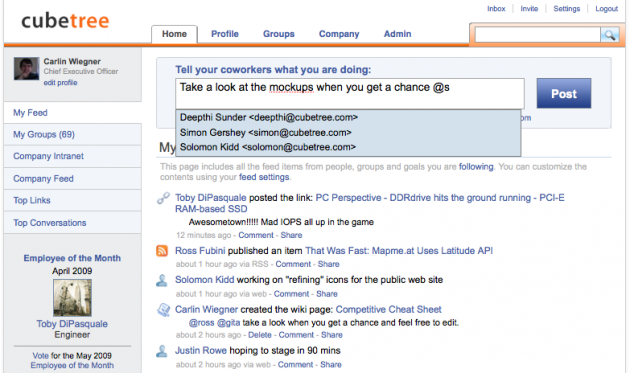
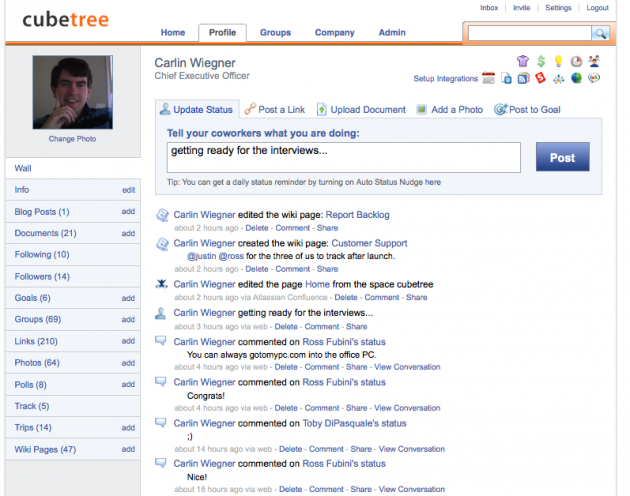
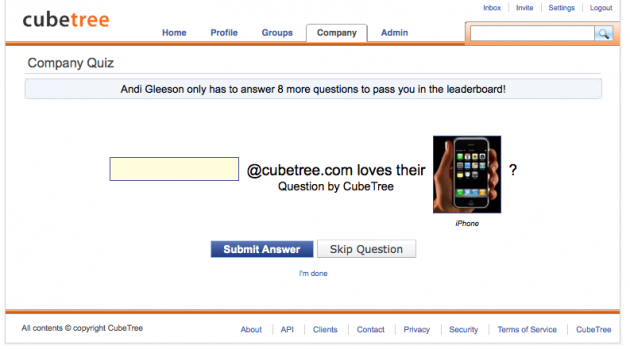


 If Facebook doesn’t want to take a moral or ethical stand on the issue, they can easily make a case that the groups violate their terms of service. These groups violate multiple sections of the
If Facebook doesn’t want to take a moral or ethical stand on the issue, they can easily make a case that the groups violate their terms of service. These groups violate multiple sections of the 
 As readers know, I'm working on a new book about global entrepreneurship that is taking me around the world at the pace of roughly one country per month for the next year and a half. The plan is to focus on several contrasting hot spots for entrepreneurship and revisit them throughout the next year or so to see how the entrepreneurs and economies evolve over that time.
As readers know, I'm working on a new book about global entrepreneurship that is taking me around the world at the pace of roughly one country per month for the next year and a half. The plan is to focus on several contrasting hot spots for entrepreneurship and revisit them throughout the next year or so to see how the entrepreneurs and economies evolve over that time. The Lois Whitman how-not-to-do-PR saga continues. She was
The Lois Whitman how-not-to-do-PR saga continues. She was 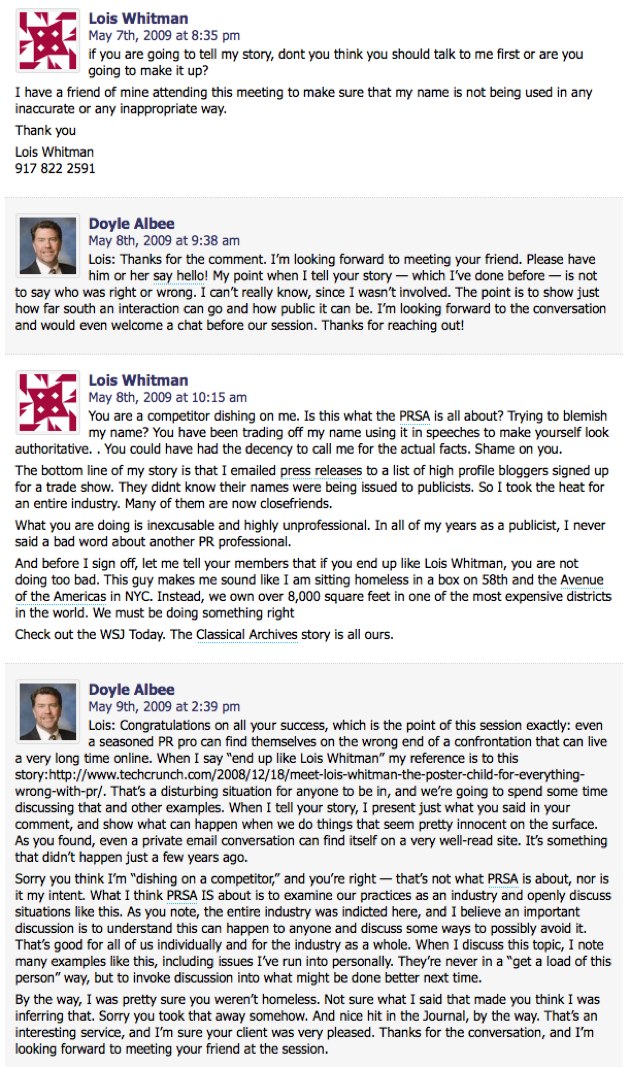
 Today is Mother’s Day; have you called your mother yet? Judging from popular topics on Facebook, Twitter, FriendFeed, etc, you have. So what else is there to do on this fine Sunday? Perhaps watch the latest
Today is Mother’s Day; have you called your mother yet? Judging from popular topics on Facebook, Twitter, FriendFeed, etc, you have. So what else is there to do on this fine Sunday? Perhaps watch the latest 
No comments:
Post a Comment